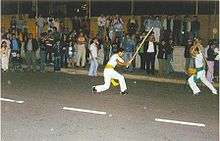Jogo do pau
 | |
| Focus | Weapons (sticks) |
|---|---|
| Country of origin |
|
| Olympic sport | No |
Jogo do pau (Portuguese pronunciation: [ˈʒoɣu du ˈpaw], "game of the stick") is a Galician and Portuguese martial art which developed along the Minho river and its surrounding regions (Minho, Trás-os-Montes, Pontevedra and Ourense), focusing on the use of a staff of fixed measures and characteristics. The origins of this martial art are uncertain, but its purpose was primarily self-defence. It was also used to settle accounts, disputes and matters of honour between individuals, families, and even villages. While popular in the northern mountains, it was practically unknown elsewhere, and those who did practise it were taught by masters from the Norte Region, Portugal and Galiza.[1]
History
The popularity of this martial art was partly due to the demeanor of the northern folk, who valued personal and family honor enough to kill for it. It was also due in no small part to the relative ease of obtaining a staff as well as the versatility of such a tool: a staff or stick was almost universally present, used as a support for the long daily walks, to help cross the rivers, by the shepherds to protect the cattle from wild animals, and so on. There are references to this martial art being used by the guerrilla against the troops of Napoleon that were occupying Lisbon during the Peninsular War.
Origin
The origins of the jogo do pau are medieval civil techniques of combat, used in times of war by foot soldiers who were often poor peasants who could not afford a better weapon. Evidence of this are found, for instance, from reports on the Battle of Aljubarrota. The technique was incorporated into horseback riding in the medieval book A ensinança de bem cavalgar em toda a sela ("The art of being a good horseman on any saddle") by Edward of Portugal (1391–1438). This martial art developed not in the urban areas more open to foreign influences, but in Galiza and the most isolated mountain regions of continental Portugal. Some believe that jogo do pau was also influenced by a southern Indian dance or martial art, which would have been imported and adapted in the period of the Discoveries when Goa was a Portuguese colony, building upon the ancient local tradition. Despite some similarities, it is not related to the traditional dance of the pauliteiros of Miranda (which has ties to Asturian folklore).
During the 19th century, jogo do pau was brought to Lisboa by northern masters, resulting in an amalgamation with the technique of the Gameirosabre, growing into a sports competition, removed from actual combat. It was practiced in clubs such as the Ginásio Clube Português and the Ateneu Comercial de Lisboa.
Modern practice
In the 20th century, the practice of jogo do pau suffered a quick decline due to the migrations from rural areas to the cities and the greater ease in access to firearms. The players born between 1910 and 1930 were the last generation to experience the flowering of the sport. The memories of this generation provided a continuity in the 1970s, when the sport was revived. The driving force of this revival was Pedro Ferreira, followed by his student Nuno Curvello Russo, who dedicated his life's ambition to jogo do pau, frequently visiting the North of Portugal, getting acquainted with surviving variants there, especially with the school of Cabeceiras de Basto. He studied at the Ateneu Comercial de Lisboa, whose master is now Manuel Monteiro. Today, the sport is still rather marginal in Portugal, but there is a stable number of practitioners organized in two federations: the Federação Portuguesa de Jogo do Pau and the Federação Nacional do Jogo do Pau Português. This art is also practised in the Azores and Madeira, and outside Portugal in Galicia, Spain.[2]
See also
Further reading
- Preto, Luis Jogo do Pau, ISBN 1480228141.
External links
- Jogo do Pau - Teaching and thoughts, by coach Preto
- freewebs.com/pontuada/
- Jogo do Pau Azores Club
- Jogo do Pau Photos (Portuguese)
- Jogo do Pau - Origins and Evolution
- Jogo do Pau by Paulo de Oliveira
- The Portuguese Staff
- Jogo do Pau - filme 4
- Jogo do Pau in the First World War - filme 5
- Jogo do Pau português - information, places to practice, etc.
- Some Jogo do Pau techniques, seminar by master Isidro Piñeiro in Compostela, Galiza, 2012.
- A esgrima nacional, lengthy article by Zacarias d'Aça published in 1883 in the Jornal de notícias which elaborates on the history and origins of Jogo do Pau as a modern martial art practised in Lisbon, including its northern (Portuguese and Galician) roots.
References
- ↑ «Há três escolas: -A do Norte, chamada galega por ser oriunda da Galiza...», regarding the existence of several different schools of jogo do pau, one of them originary from Galiza. «Os seus professores foram os mais dextros que então havia em Lisboa --um d'elles era gallego.», regarding the galician master that taught José Maria da Silveira, the founder of the Lisboa school of jogo do pau in the 19th century. Source: Zacarias d'Aça, «A esgrima nacional», article written in the Diário da Manhã in 1883. http://www.slideshare.net/jogodopaupt/esgrima-nacional-zacarias-daca-1883
- ↑ "Some Jogo do Pau Techniques Gathered from Galician Oral Tradition, a jogo do pau seminar taught by master Isidro Piñeiro, Santiago de Compostela, Galiza, 2012: https://www.youtube.com/watch?v=OEaZcvDM7DA